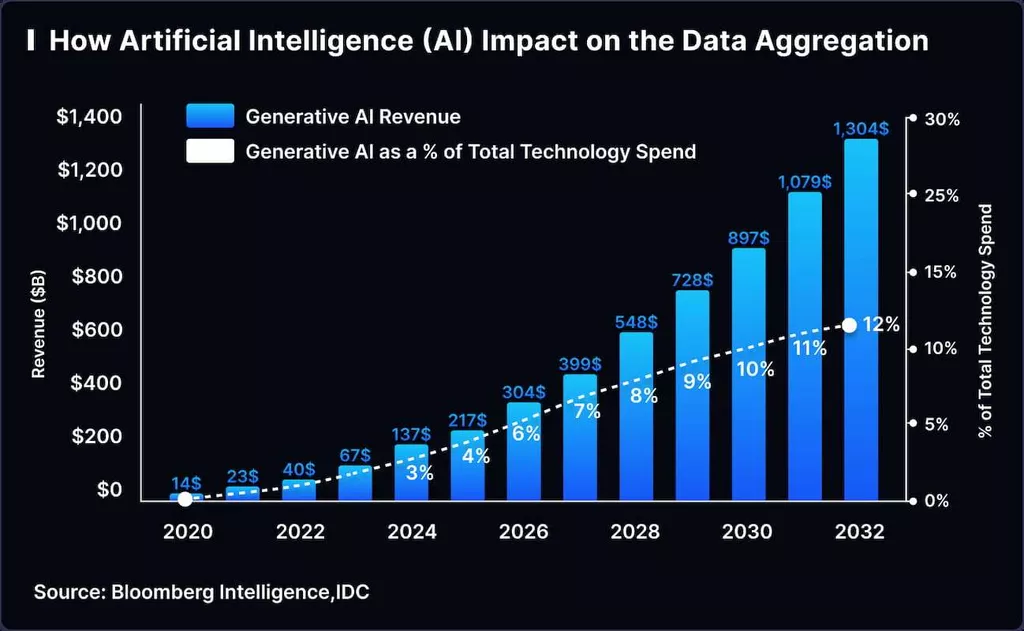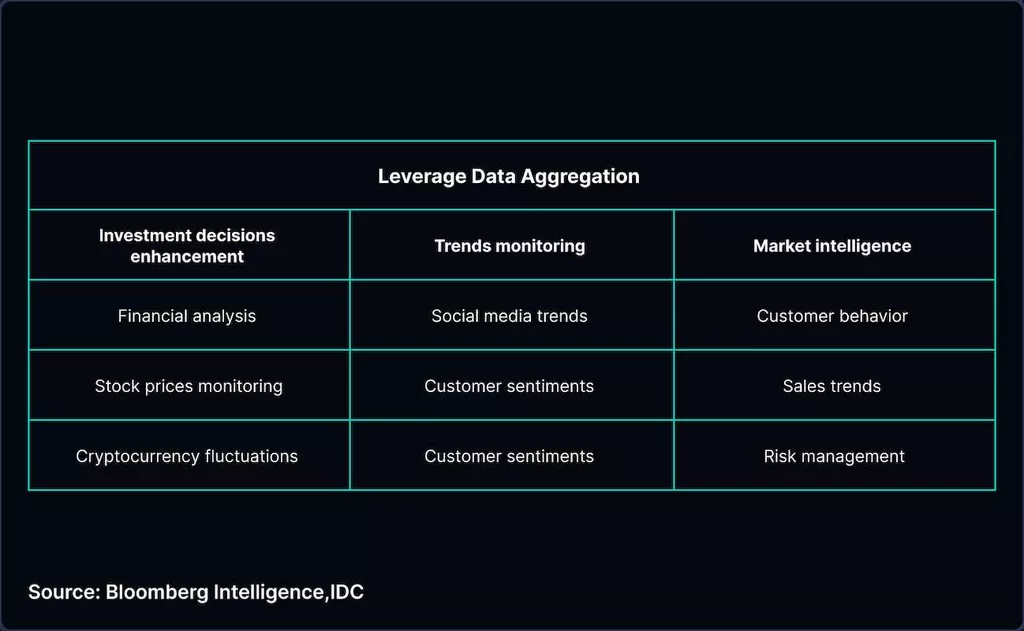Although we remember 2023 as the period when society began actively utilizing generative AI (genAI) and ChatGPT, we still do not realize the true transformative potential of business intelligence tools. With recent use cases gaining momentum, we will soon see the real possibilities of artificial intelligence data aggregation.
According to Bloomberg, the genAI market will be worth $1.3 trillion by 2032, and its impact will be felt across all industries. Regarding business analytics, AI-backed systems allow you to work with a large dataset and help companies make rational decisions. Overall, artificial intelligence has the potential to perform data aggregation on an unprecedented scale. This blog post explains the procedure and why AI has radically changed data aggregation.

Definition and Advantages of Data Aggregation
Data aggregation is the procedure of collecting and combining information obtained from numerous sources in a centralized repository. This process involves collecting raw atomic data and transforming it into a structured and usable form. Aggregated data can be multiple types of information, e.g., numbers, texts, etc. By consolidating different datasets, firms can get a complete view of their activities, client base, and tendencies in the evolving area. Let’s look at other profits:
- Optimal decision-making: By combining insights from diverse sources and analyzing them immediately, you may make rational choices to improve operational efficiency and client satisfaction.
- Simplified data workflow: Firms may adopt a single dashboard to monitor key metrics, including sales performance and customer segmentation. This system allows you to identify tendencies quickly.
- Improved insights quality: During aggregation, insights are cleaned to reach high-quality insights. It allows you to work with correct information, avoiding errors and inconsistencies.
By 2025, about 180 zettabytes of information will be generated worldwide. This influx of information makes data automation a vital tool for the development of any business, so you need to think about applying it today.
How Does Data Aggregation Occur?
Aggregators combine atomic insights from various sources, analyze them to obtain new insights, and present the procedure’s results in a human-readable form. Modern aggregators based on artificial intelligence allow you to control the origin of information and study the underlying data based on which the aggregation took place. Let’s consider the primary phases of the process:
- Insights collection: Systems receive information from numerous sources, storing it in central datasets as atomic insights. In most cases, insights are obtained from conversations on social networks, news, users’ data, and call centers through AI-backed speech recognition platforms.
- Information analysis: After receiving data, it needs to be processed. The aggregator determines the elements that should be aggregated. It processes databases with predictive analytics, AI-backed tools, and data aggregation machine learning structures to generate new facts. The aggregator also uses the necessary statistical functions.
- Demonstration of results: You can show aggregated information in a generalized form, a new database. The statistical information is correct and complete if the process is carried out correctly.
You can perform the procedure manually or adopt data aggregation intelligence software. If you have much information to handle, entrusting the process to AI-driven systems is better. Otherwise, you risk missing key insight sources and not noticing tendencies.
Exploring the Way AI Revolutionizes Data Aggregation
Artificial intelligence automates and refines data aggregation. With AI-backed systems, users may collect, process, and analyze significant datasets in real time for maximum efficiency. AI searches datasets for patterns and trends to produce precise and valuable results. Let’s explore the main sectors where AI-backed structures have the greatest impact:
- Cleaning datasets: You may eliminate unnecessary information and get a high-quality database by detecting and removing errors, duplicate insights, and inconsistencies.
- Information integration: This procedure allows you to combine insights from various sources by searching and comparing similar fields and attributes. It decreases the time and energy required to integrate information.
- Data analysis: AI-backed instruments allow you to process aggregated information utilizing unique schemes and machine learning structures. This way, companies receive important insights and may make forecasts based on aggregated data.
As progress develop, the capabilities of AI will expand. Shortly, we will see the development of composable AI data analytics, which successfully deals with big data to optimize user apps in the business.
Key Problems with AI-Ruled Data Aggregation
Despite all the advantages of artificial intelligence data aggregation, this procedure is associated with specific problems and risks that should be addressed in advance. Most often, clients encounter the following difficulties:
- Security risk: If you adopt a third-party platform for aggregated data, it is essential to ensure that it has the latest security features to lower the risk of criminals gaining access to your database. Modern encryption protocols, constant security monitoring, and access restrictions are mandatory functions.
- Poor insights quality: An AI-driven platform must utilize accurate and consistent insights to ensure fair results. That’s why, before you start working with an aggregator, you must create a tracking project to save time on insights control and prevent using low-quality statistics.
Data and AI solutions for aggregation must be synchronized with other systems you utilize when working with figures, e.g., Google Analytics, client service instruments, and marketing solutions. If you refuse integration, you will end up with separate silos that will not provide a complete picture of your activities.

Any industry generates a considerable volume of insights. Companies utilize data analysis to perform various tasks, from pricing to product creation, recruiting, and advertising campaigns. Let’s consider several use cases of AI data aggregation in numerous sectors:
- Marketing teams collect information about campaigns and the channels they utilize for promotion. Experts can aggregate insights from a particular campaign to evaluate its effectiveness over time and aggregate its results with other sets of promotional efforts for comparison to understand how different segments of the target audience respond to the promotion.
- Websites focusing on popularizing content can group guests by region, period of visit, and time spent on the site. Aggregation lets you estimate which articles were most in demand to improve user experience.
- Online stores can process information to determine periods of maximum and minimum visits, the number of operations, and whether the customer makes orders based on recommendations. Such businesses may also collect information about competitors: what products they offer, at what cost, and whether they have promotions.
- The activities of economic institutions are connected with world news since even a minor event can affect the state of affairs in the background market. Combining news headlines and text form the basis for predictive analytics.
- Even healthcare is seeing the profits of information aggregation. By combining many anamnesis and medical reports, medical specialists can create effective therapy to alleviate the disease.
Remember that data aggregation procedures and methods may vary depending on the situation, the analysis, and the required use case. The aggregation procedure may be simplified through the introduction of automated tools.
Final words
We are at the beginning of the active use of artificial intelligence, and organizations are still trying to figure out the optimal ways to utilize the technology. Shortly, AI will offer more effective options for working with analytical insights. Whether enterprises are adding chatbots to communicate with clients or providing deeper data analytics, the future of artificial intelligence data aggregation will bring many valuable discoveries.
If you also plan to utilize AI-driven instruments to work with insights, consult MetaDialog specialists. We offer optimal platforms to support enterprise AI. Our technologies, adapted to your business processes and goals, easily synchronize with your business intelligence tools and software.
